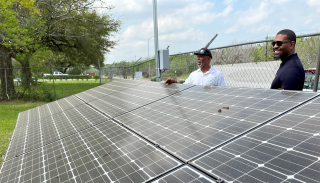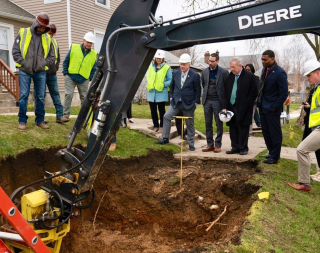5 Ways EPA is Protecting People and the Planet
53 years ago, Americans came together to celebrate the first Earth Day, uniting millions in demanding action on pollution and paving the way for a new era of environmental activism. It was a wake-up call to our government: people all over the country care deeply about protecting the environment.
As a result, the Environmental Protection Agency was created. In the decades since, we have made substantial progress: cleaner air for our children to breathe, safer water flowing through our taps, stronger protections against dangerous chemicals, and more.
But there is still work to be done. The Biden-Harris Administration understands that the health of the planet and the health of its people are inextricably linked. These past few months, EPA has moved further and faster than ever before to build a healthier and brighter future for all.
Here are 5 ways we are protecting people and the planet…
#1 Tackling the climate crisis with the urgency it demands

- We proposed the strongest-ever technology standards for cars and trucks, accelerating the transition to a clean transportation future. This proposal will cut 10 billion tons of greenhouse gas emissions – which is more than double the total amount of emissions from the U.S. in 2022.
- We’re investing $5 billion to equip local governments with the resources they need to create innovative strategies that cut climate pollution.
#2 Confronting longstanding environmental injustices and inequities

- Too many communities face significant barriers when it comes to accessing federal resources. That’s why we’re investing $177 million in 17 new technical assistance centers to help historically underserved communities build capacity to access funds from President Biden’s Investing in America agenda and advance environmental justice.
- With $27 billion from the historic Inflation Reduction Act, EPA’s Greenhouse Gas Reduction Fund will mobilize billions more in private capital to reduce pollution and improve public health. And we’re implementing these programs under President Biden’s Justice40 Initiative, which directs that 40% of the overall benefits of federal investments flow to disadvantaged communities.
#3 Improving air quality in neighborhoods across the country

- We’re taking action to cut harmful air pollution with new proposed technology standards. EPA proposed to strengthen the Mercury and Air Toxics Standards to cut hazardous air pollutants from power plants. We also proposed standards for chemical and polymer plants – which would reduce the number of people with elevated cancer risk by 96% in nearby communities.
- EPA finalized our plan to cut smog pollution from power plants and industrial facilities, which will not only improve air quality, but save lives, keep people out of the hospital, and prevent asthma attacks.
#4 Ensuring clean water for all families

- Through President Biden’s Investing in America agenda, we’re investing billions of dollars to rebuild our nation’s water infrastructure and advance our commitment to removing 100% of lead pipes.
- We proposed the first-ever legal limits for PFAS – “forever chemicals” that are known to cause harmful health effects – in drinking water. These standards would require public water systems to monitor for PFAS and reduce contamination if levels exceed acceptable amounts.
#5 Building a healthier future

- Through the Clean School Bus Program, EPA awarded 2,400 clean school buses to school districts in every corner of the country. This program is not only protecting the health of our kids, but accelerating a zero-emission transportation future.
- We invested $1 billion this year to start new cleanup projects at 22 Superfund sites – some of the nation’s most contaminated lands – and expedite cleanup at another 100 sites.
The last few months have given us plenty of reasons to celebrate. From replacing lead pipes to reducing air pollution, I am proud of the progress we have made for communities in every corner of this country.
Our efforts to combat climate change, advance environmental justice, and protect public health have never been more urgent. This Earth Day, we’re committed to continuing this work to build a healthy and sustainable future for all people and the planet.
This is what investing in America looks like. Let’s go!

About the Author
Michael Regan
EPA Administrator
Office of the Administrator
Michael S. Regan was sworn in as the 16th Administrator of the United States Environmental Protection Agency on March 11, 2021, becoming the first Black man and second person of color to lead the U.S. EPA.
Prior to his nomination as EPA Administrator, Michael Regan served as the Secretary of the North Carolina Department of Environmental Quality (DEQ) where he spearheaded the development and implementation of North Carolina's seminal plan to address climate change and transition the state to a clean energy economy.
Previously, Administrator Regan served as Associate Vice President of U.S. Climate and Energy, and as Southeast Regional Director of the Environmental Defense Fund. He began his career with the U.S. Environmental Protection Agency, eventually becoming a national program manager responsible for designing strategic solutions with industry and corporate stakeholders to reduce air pollution, improve energy efficiency and address climate change.
Throughout his career, he has been guided by a belief in forming consensus, fostering an open dialogue rooted in respect for science and the law, and an understanding that environmental protection and economic prosperity go hand in hand.
A native of Goldsboro, North Carolina, Administrator Regan is a graduate of the North Carolina Agricultural & Technical State University – making him the first EPA Administrator to have graduated from a Historically Black College and University. He earned a master's degree in Public Administration from The George Washington University. He and his wife Melvina are proud parents to their son, Matthew.
Editor’s Note: The views expressed here are intended to explain EPA policy. They do not change anyone’s rights or obligations. You may share this article. However, please do not change the title or the content, or remove EPA’s identity as the author. If you do make substantive changes, please do not attribute the edited title or content to EPA or the author.
EPA’s official web site is www.epa.gov. Some links on this page may redirect users from the EPA website to specific content on a non-EPA, third-party site. In doing so, EPA is directing you only to the specific content referenced at the time of publication, not to any other content that may appear on the same webpage or elsewhere on the third-party site, or be added at a later date.
EPA is providing this link for informational purposes only. EPA cannot attest to the accuracy of non-EPA information provided by any third-party sites or any other linked site. EPA does not endorse any non-government websites, companies, internet applications or any policies or information expressed therein.
